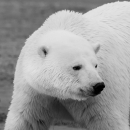Damage response, Monitoring, Research
With the approval of oil and gas leasing in the 1002 Area of Alaska, the Service initiated a study to estimate the potential impacts of a late summer, near-shore oil spill on polar bears. We simulated oil spills at three locations along the 1002 Area coastline in late summer/early autumn and assumed spills came from an underwater pipeline rupture that lasted 6 days and which the oil was tracked for a 50-day period. Based on previous studies of onshore polar bear density and space use, we will estimate how many bears could possibly be exposed to oil.




